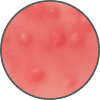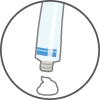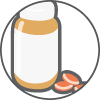Living with Rosacea
MEDICATIONS FOR ROSACEA
 |
Self-treating with over-the-counter products may not help and may aggravate and irritate skin more, causing more severe redness and bumps.1 |
 |
Topical creams (Metronidazole, antibiotics, steroids, Tretinoin, Sodium sulfacetamide and sulphur ).1 |
 |
Oral prescription medications (antibiotics like: tetracycline, minocycline, erythromycin, clindamycin, and others; isotretinoin).1 |
 |
Laser therapy and other cosmetic surgery (pulsed dye laser or intense pulsed light (IPL), laser resurfacing, dermabrasion, or cosmetic surgery).1 |
POINTS TO REMEMBER ABOUT ROSACEA MEDICATION
- Sticking with the treatment recommended by your doctor will improve symptoms within a few weeks.1
- Compliance with therapy – using your medication exactly as your doctor prescribes it – is an important key to success.6
- Apply any topical medication and allow it to absorb completely before you apply moisturizer or makeup.7
- Rosacea is characterized by flare-ups and remissions. It is best to keep using your medications in between flare-ups in order to prevent them.8

REFERENCES
- Skin Care: Sunscreens. Acne and Rosacea Society of Canada. http://www.rosaceahelp.ca/take-action/rosacea-skin-care-sunscreen/. Published April 22, 2016. Accessed August 19, 2016.
- Sunscreen. National Rosacea Society. https://www.rosacea.org/patients/skincare/sunscreen. Published 2016. Accessed August 19, 2016.
- Facial Cleansing for Rosacea. National Rosacea Society. https://www.rosacea.org/patients/skincare/facialcleansing. Published 2016. Accessed August 19, 2016.
- Moisturizer. National Rosacea Society. https://www.rosacea.org/patients/skincare/moisturizer. Published 2016. Accessed August 19, 2016.
- Make-up and Concealers. Acne and Rosacea Society of Canada. http://www.rosaceahelp.ca/take-action/action-article-7/. Published December 12, 2014. Accessed August 19, 2016.
- For Men: Shaving Tips for Skin with Rosacea. National Rosacea Society. https://www.rosacea.org/patients/skincare/shavingtips.php. Published 2016. Accessed August 19, 2016.
- Rosacea. National Institute of Arthritis and Musculoskeletal and Skin Diseases. http://www.niams.nih.gov/Health_Info/Rosacea/default.asp#1. Published April 2016. Accessed August 19, 2016.
- Rosacea: Diagnosis and Treatment. American Academy of Dermatology. https://www.aad.org/public/diseases/acne-and-rosacea/rosacea#treatment. Published 2016. Accessed August 19, 2016.
- Living with Rosacea. Canadian Dermatology Association. http://www.dermatology.ca/skin-hair-nails/skin/rosacea/#!/skin-hair-nails/skin/rosacea/living-with-rosacea/. Published 2016. Accessed August 19, 2016.
- Rosacea. Canadian Dermatology Association. http://www.dermatology.ca/skin-hair-nails/skin/rosacea/. Published 2016. Accessed August 19, 2016.
- Rosacea: Signs and Symptoms. American Academy of Dermatology. https://www.aad.org/public/diseases/acne-and-rosacea/rosacea#causes. Published 2016. Accessed August 19, 2016.
- When to see a Doctor. Acne and Rosacea Society of Canada. http://www.rosaceahelp.ca/about-rosacea/when-to-see-a-doctor/. Published 2016. Accessed August 19, 2016.
- How Do I Treat Skin Thickening? Acne and Rosacea Society of Canada. http://www.rosaceahelp.ca/take-action/action-article-8/. Published December 10, 2014. Accessed August 19, 2016.
